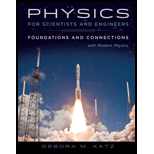
Concept explainers
(a)
The state of energy after it enters into the system where we pull a sled across a frozen lake. Also find whether the speed can remain constant or not if there is kinetic energy after doing the work.
(a)
Answer to Problem 1PQ
The thermal energy of ice and sled increases and the kinetic energy of sled also increases. Also constant speed can be maintained.
Explanation of Solution
Here the situation is pulling of a sled across a frozen lake. The system here is not completely frictionless. Therefore, the thermal energy of the system increases. The sled can move in constant speed. Also the kinetic energy of the sled can be increased as extra energy can be added to the system.
Conclusion:
Therefore, the thermal energy of ice and sled increases and the kinetic energy of sled also increase and constant speed can be maintained.
(b)
The state of energy after it enters into the system where we pull a sled up a snowy hill.
(b)
Answer to Problem 1PQ
Thermal energy will increase surely but the increase of kinetic energy is not sure.
Explanation of Solution
Here the sled is moved up a snowy hill. The system is not completely frictionless. So the frictional energy will increase. As the sled is moved up along a snowy hill against the gravity, the gravitational potential energy of the system will increase.
Conclusion:
Therefore, the thermal energy will increase surely but the increase of kinetic energy is not sure.
(c)
The state of energy after it enters into the system where a string wrapped around a pulley with a fixed axle is pulled.
(c)
Answer to Problem 1PQ
The thermal energy of the system increases, rotational energy may increase or remain constant.
Explanation of Solution
If the surface offers friction, the thermal energy of the system increases. If the spring rotates about the axle, the rotational energy increases. If the friction dissipates energy from the system, the rotational kinetic energy may increase or remain constant.
Conclusion:
Therefore, the thermal energy of the system increases, rotational energy may increase or remain constant.
(d)
The state of energy after it enters into the system where a cart with large wheels across a flat ground is pulled.
(d)
Answer to Problem 1PQ
The thermal energy of the system will increase, translational and rotational kinetic energy may also increase.
Explanation of Solution
If dissipative
Conclusion:
Therefore, the thermal energy of the system will increase, translational and rotational kinetic energy may also increase.
Want to see more full solutions like this?
Chapter 13 Solutions
Webassign Printed Access Card For Katz's Physics For Scientists And Engineers: Foundations And Connections, 1st Edition, Single-term
- Hi! I need help with these calculations for part i and part k for a physics Diffraction Lab. We used a slit width 0.4 mm to measure our pattern.arrow_forwardExamine the data and % error values in Data Table 3 where the angular displacement of the simple pendulum decreased but the mass of the pendulum bob and the length of the pendulum remained constant. Describe whether or not your data shows that the period of the pendulum depends on the angular displacement of the pendulum bob, to within a reasonable percent error.arrow_forwardIn addition to the anyalysis of the graph, show mathematically that the slope of that line is 2π/√g . Using the slope of your line calculate the value of g and compare it to 9.8.arrow_forward
- An object is placed 24.1 cm to the left of a diverging lens (f = -6.51 cm). A concave mirror (f= 14.8 cm) is placed 30.2 cm to the right of the lens to form an image of the first image formed by the lens. Find the final image distance, measured relative to the mirror. (b) Is the final image real or virtual? (c) Is the final image upright or inverted with respect to the original object?arrow_forwardConcept Simulation 26.4 provides the option of exploring the ray diagram that applies to this problem. The distance between an object and its image formed by a diverging lens is 5.90 cm. The focal length of the lens is -2.60 cm. Find (a) the image distance and (b) the object distance.arrow_forwardPls help ASAParrow_forward
 College PhysicsPhysicsISBN:9781938168000Author:Paul Peter Urone, Roger HinrichsPublisher:OpenStax College
College PhysicsPhysicsISBN:9781938168000Author:Paul Peter Urone, Roger HinrichsPublisher:OpenStax College Physics for Scientists and Engineers: Foundations...PhysicsISBN:9781133939146Author:Katz, Debora M.Publisher:Cengage Learning
Physics for Scientists and Engineers: Foundations...PhysicsISBN:9781133939146Author:Katz, Debora M.Publisher:Cengage Learning
 Glencoe Physics: Principles and Problems, Student...PhysicsISBN:9780078807213Author:Paul W. ZitzewitzPublisher:Glencoe/McGraw-Hill
Glencoe Physics: Principles and Problems, Student...PhysicsISBN:9780078807213Author:Paul W. ZitzewitzPublisher:Glencoe/McGraw-Hill College PhysicsPhysicsISBN:9781305952300Author:Raymond A. Serway, Chris VuillePublisher:Cengage Learning
College PhysicsPhysicsISBN:9781305952300Author:Raymond A. Serway, Chris VuillePublisher:Cengage Learning Principles of Physics: A Calculus-Based TextPhysicsISBN:9781133104261Author:Raymond A. Serway, John W. JewettPublisher:Cengage Learning
Principles of Physics: A Calculus-Based TextPhysicsISBN:9781133104261Author:Raymond A. Serway, John W. JewettPublisher:Cengage Learning





